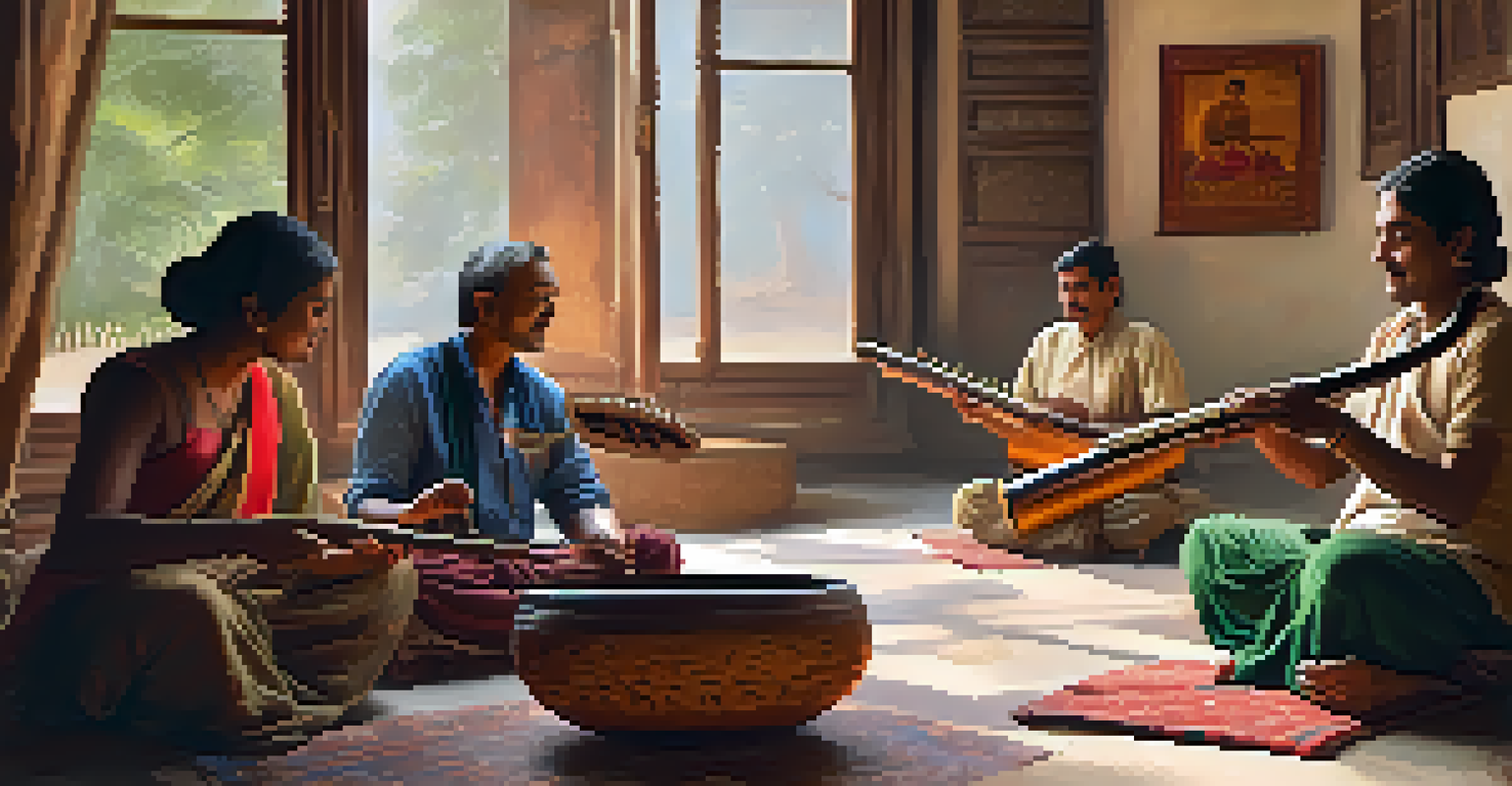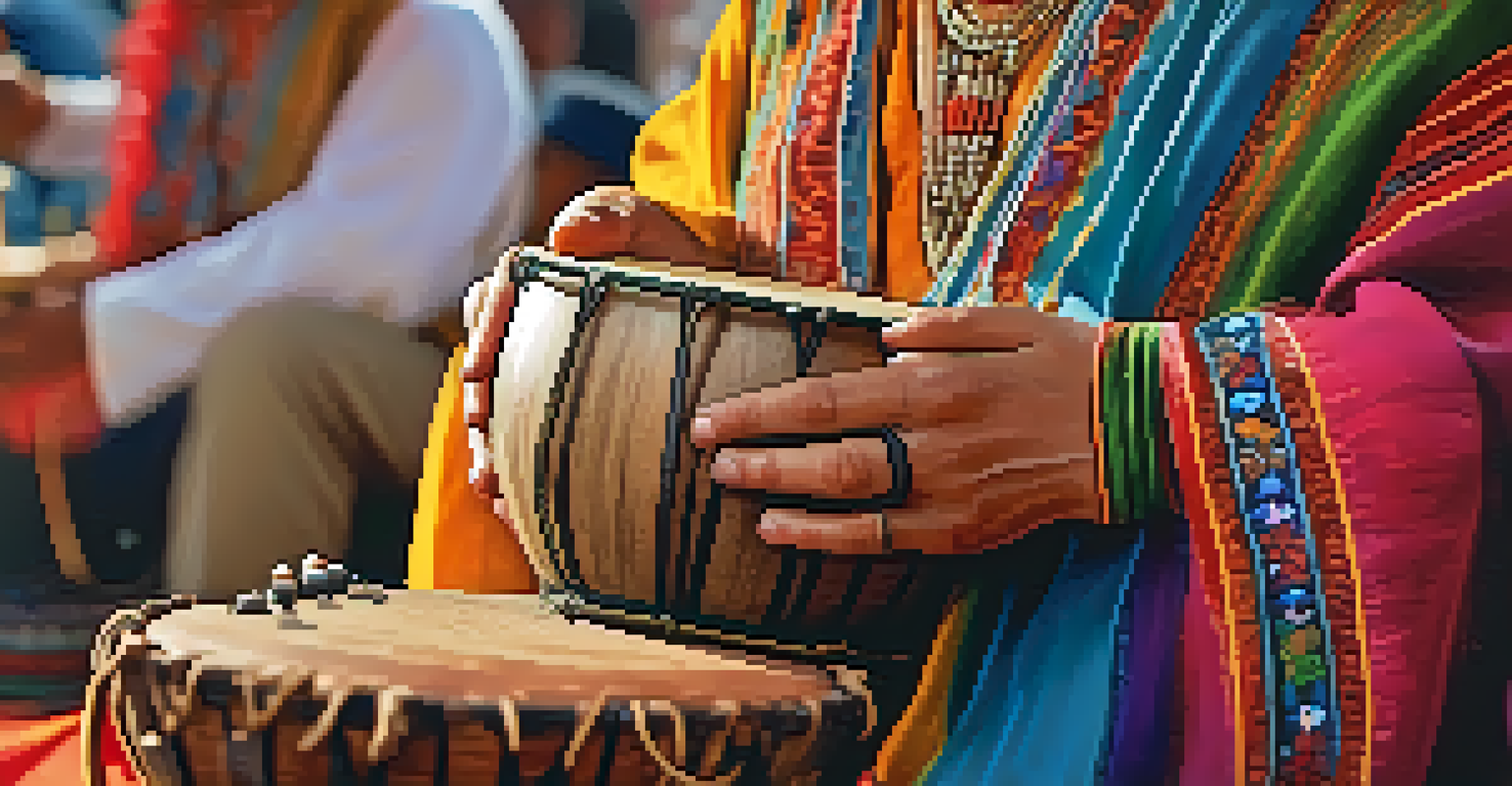The Role of Folk Music in India's Cultural Tourism Landscape

Understanding India's Rich Folk Music Traditions
India's folk music is a vibrant tapestry that reflects its diverse cultures and histories. Each region boasts unique styles, instruments, and themes that tell stories of daily life, spirituality, and social issues. For instance, the lively beats of Bhangra from Punjab contrast beautifully with the soulful melodies of Baul music from Bengal. Together, these traditions create a rich auditory experience that captivates both locals and tourists alike.
Where words fail, music speaks.
Folk music serves as a living archive, preserving the oral history of communities across India. Songs often celebrate festivals, rituals, and significant life events, making them integral to cultural practices. For example, the Garba dance music during Navratri not only entertains but also unites communities, inviting visitors to participate and appreciate the local customs. This engagement fosters a deeper connection between tourists and the culture they explore.
As cultural tourism grows, understanding these folk traditions becomes essential for anyone looking to experience India authentically. Tourists are increasingly seeking immersive experiences, and folk music offers an accessible entry point into the country’s rich heritage. By listening to and engaging with local artists, visitors can gain insights into the values and traditions that shape India's diverse societies.
Folk Music as a Catalyst for Cultural Exchange
Folk music acts as a bridge, connecting people from different backgrounds and facilitating cultural exchange. When tourists attend folk music performances, they not only witness the artistry but also engage in conversations with local artists and communities. This interaction fosters mutual respect and understanding, breaking down stereotypes and building friendships across cultures.

For example, festivals like the Rajasthan International Folk Festival attract artists and audiences from around the globe, creating a melting pot of cultural experiences. Such events highlight how folk music can transcend borders, inviting collaboration and innovation among artists. This spirit of exchange enriches both the performers and the audience, showcasing the universal language of music.
Folk Music as Cultural Heritage
India's folk music serves as a vibrant archive of local traditions, reflecting community values and histories.
Moreover, folk music can also inspire tourists to explore deeper into the culture of a region. With many folk songs reflecting local legends and historical narratives, listeners often find themselves intrigued by the stories behind the melodies. This curiosity encourages further exploration of traditions, crafts, and cuisines, leading to a more holistic travel experience.
The Economic Impact of Folk Music on Tourism
Folk music plays a significant role in boosting the local economy through cultural tourism. Events centered around folk performances attract tourists, generating income for local artists, craftsmen, and businesses. For instance, the rise of folk music festivals has led to increased sales of traditional crafts and food, benefiting the entire community.
Music is the universal language of mankind.
In many regions, folk music is intertwined with tourism initiatives aimed at promoting local culture. Governments and organizations often invest in preserving these musical traditions, recognizing their potential to draw visitors. This investment not only sustains the art form but also creates jobs in tourism, hospitality, and related sectors, ultimately enhancing the region’s economic viability.
Furthermore, as tourists share their experiences through social media, the visibility of folk music increases, attracting even more visitors. This digital word-of-mouth marketing highlights the power of folk music in shaping perceptions of a destination. As a result, areas rich in folk traditions can become sought-after travel spots, further cementing the link between music and tourism.
Challenges Facing Folk Music in the Tourism Sector
Despite its importance, folk music faces several challenges in the tourism landscape. One significant issue is the risk of commercialization, where authentic performances may be diluted to cater to tourist expectations. This shift can lead to a loss of cultural integrity, as artists may feel pressured to prioritize entertainment over tradition.
Additionally, many folk musicians struggle with financial instability, making it difficult for them to sustain their art forms. While festivals and performances can provide temporary income, the lack of consistent support and recognition often hampers their ability to thrive. As a result, some regions may see a decline in folk music traditions, impacting cultural tourism negatively.
Tourism Boosts Local Economies
Folk music festivals not only attract tourists but also generate income for local artists and businesses, enhancing the economy.
To address these challenges, it's crucial for stakeholders—including government bodies, NGOs, and the tourism industry—to collaborate on sustainable practices. Supporting local artists through fair compensation and promoting genuine experiences can help preserve these traditions. In doing so, they ensure that folk music continues to be a vibrant part of India's cultural tourism landscape.
The Role of Technology in Promoting Folk Music
Technology plays a pivotal role in enhancing the visibility of folk music, making it more accessible to a global audience. Social media platforms allow artists to share their work widely, reaching enthusiasts who might never have experienced their music otherwise. This digital presence not only celebrates their art but also fosters connections with fans around the world.
Moreover, online streaming services have made it easier for listeners to discover and support folk artists. Playlists featuring regional folk music can introduce tourists to the sounds of India before they even set foot in the country. This pre-trip exposure can generate interest and excitement, encouraging travelers to seek out live performances during their journey.
Additionally, technology facilitates the documentation and preservation of folk music traditions. Through video recordings and digital archives, unique performances can be saved for future generations. This effort not only safeguards cultural heritage but also allows tourists to appreciate the depth and diversity of India's folk music landscape.
Engaging Tourists Through Interactive Folk Music Experiences
Interactive folk music experiences can significantly enhance a tourist's visit, providing memorable and educational moments. Workshops that teach traditional instruments or dances allow visitors to immerse themselves in the culture actively. These hands-on experiences can transform passive listeners into engaged participants, fostering a better understanding of local traditions.
For instance, many cultural tourism companies offer guided tours that include visits to local music schools or homes of folk artists. Such initiatives not only promote the artists but also provide tourists with a personal connection to the music. Engaging directly with the creators helps visitors appreciate the skill and passion involved in folk music.
Challenges in Preservation
Authenticity risks and financial instability threaten folk music traditions, highlighting the need for sustainable support.
Additionally, festivals that encourage audience participation—such as sing-alongs or dance-offs—create an inclusive atmosphere. This sense of community enriches the tourist experience, making them feel like they are part of something larger than themselves. Ultimately, these interactive moments deepen the relationship between tourists and the culture, fostering respect and appreciation for India's folk music heritage.
The Future of Folk Music in Cultural Tourism
The future of folk music in India's cultural tourism landscape looks promising, as there's a growing appreciation for authenticity among travelers. As tourists seek unique experiences, folk music offers an unparalleled glimpse into the heart of local cultures. This trend encourages communities to revitalize and promote their musical heritage, ensuring its sustainability.
Moreover, as more artists experiment with blending traditional folk elements with contemporary genres, new audiences are being drawn to these sounds. Collaborations between folk musicians and popular artists can introduce folk music to a wider demographic, sparking interest and participation in cultural tourism. This fusion of old and new keeps the music relevant while honoring its roots.

To safeguard this future, ongoing support for folk musicians and cultural initiatives is vital. By investing in education, community programs, and digital platforms, stakeholders can ensure that folk music thrives for generations to come. This commitment not only preserves a rich cultural legacy but also enhances the vibrancy of India’s cultural tourism landscape.